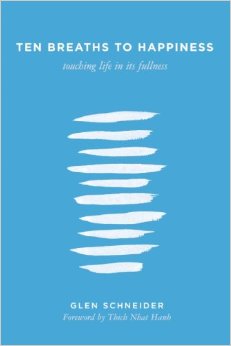
Mindfulness for Parents: 10 Breaths
This article was authored by Lynne Kennedy, Senior Training Consultant,
at the Australian Childhood Foundation. (repost)
When we think of activities that make us happy, breathing probably isn’t the first thing that spring to mind. It’s an automatic function that is in the background of our day. But we can actually use breathing to bring happiness into our day. We can use breathing to savour life’s beauty and enrich our everyday experiences.

From research into neuroscience we know now that happiness is far more than a great feeling that comes and goes, happiness is wired into the physiology of our brains. It is a skill we can all develop through practising mindfulness. In Ten Breaths to Happiness, Schneider presents a group of simple practices and guided meditations that allow us to “literally rewire our neural pathways to experience deeper and more lasting fulfilment and peace.”
From this booklet comes the “10 breaths” practice –a mindfulness practice added to our collection of mindfulness exercises in the Bringing Up Great Kids Program that has “hit the sweet spot” with parents.
“10 breaths” teaches the skills of savouring the moment and comes from a little booklet called “10 breaths to happiness – touching life in its fullness” (Glen Schneider 2013).
The exercise is simple. Basically, we are encouraged to take ten mindful breaths whenever we encounter something beautiful or have a meaningful experience. Studies in neuroscience show that it takes about thirty seconds to build a new neural-pathway.
If we’re taking 10 breaths while savouring a positive experience on a regular basis, we’re slowly rewiring our brains. This way, “patterns of happiness become habitual and deeply nourishing.”
Regularly practising this simple exercise gives the brain an opportunity to move from its default reaction of protection to one of appreciation and spaciousness. When something delightful affects you, savour the experience by giving it 10 full breaths. By paying close attention to these times, we become aware that opportunities for happiness present themselves numerous times every day.
The next time you see, smell, hear or feel something wonderful, stop and give it your full attention. Use your breath to deepen the experience so you can truly “savour” it.
This is what we teach parents in the BUGK Program – perhaps you can think of additional opportunities that might work with the families you are engaging?:
Give your 10 breaths to anything that seems wonderful to you
- Something beautiful from Nature
- A special moment with your child/partner/friend
- A piece of music
- Eating something delicious
- A work of art
Procedure:
- Stop whatever you are doing
- Close your eyes, place a hand on your belly and take 3 deep breaths to calm yourself.
- Open your eyes and focus on your special object/person/experience
- Stay focused on whatever has caught your attention as you ‘count with your body’, 10 slow breaths, by pressing and releasing in turn, each finger resting on your belly.
- If you are still entranced by your special moment, repeat the 10 breaths practice again.
- Look for opportunities in your day to repeat this practice
Here is what some parents have said:
“I gave 10 breaths to my kids when they were playing together and being kind to each other”
“10 breaths when I was walking along the beach with my husband”
“10 breaths to a clean kitchen (it didn’t last long!)”
“I gave 10 breaths to watching and listening to my baby sleeping”
“10 breaths to a peaceful drive to school!”
“I gave 10 breaths to my cup of tea this morning”
Because our breath is always with us, always available to us, we can use the 10 breaths any time, any place and with any experience. As Schneider writes, “Please don’t limit yourself.”
We encourage parents to find something to give “10 breaths” to every day.
What will you give “10 breaths” to today?
